Are you a beginner looking to dive into the world of web design? Don’t worry, we’ve got you covered. At WebsiteDesigner.Business, we specialize in providing beginner-friendly web design services that make the process easy and accessible for everyone. Whether you have zero experience or just need a refresher, our step-by-step tutorials and user-friendly approach will help you unlock the power of web design. With our guidance, you’ll be creating stunning websites in no time.
Key Takeaways:
- Our beginner-friendly web design services are tailored to help newcomers navigate the complexities of web design.
- Web design focuses on creating functional and visually pleasing websites, without the need for coding knowledge.
- The web design process involves setting goals, designing a sitemap, creating content, and more.
- Key elements like layout, navigation, and typography significantly impact the user experience.
- Find inspiration from other designers and outside sources to enhance your creative senses.
Understanding the Basics of Web Design
When it comes to web design, it’s more than just creating visually appealing websites. Understanding the basics is crucial, especially for beginners like you who are looking for beginner-friendly web design solutions. At our platform, we strive to simplify web design for dummies, making it accessible to anyone interested in creating stunning websites.
Web design encompasses essential elements such as navigation, categorization, and interaction. It’s about resolving issues and ensuring that websites are both functional and visually pleasing. As a beginner, you don’t need to worry about coding or complex technicalities. Instead, focus on creating websites that visitors can easily interact with.
Let’s dive into the basic web design principles:
- User-Friendly Navigation: Make sure your website is easy to navigate. Organize the content and use intuitive menu structures, allowing visitors to find what they’re looking for effortlessly.
- Clear Categorization: Categorize your content logically, making it easy for visitors to navigate through different sections and find relevant information efficiently.
- Interactive Design: Engage your visitors by incorporating interactive elements such as buttons, sliders, and forms. These elements enhance user experience and encourage interaction.
“Good web design is about creating a user-friendly experience that resonates with your target audience.”
The Distinction Between Web Design and Web Development
It’s important to note that web design and web development are two separate disciplines. While web development focuses on programming and coding, web design is more about the visual and functional aspects of a website. As a beginner, you can excel in web design without needing to delve into complex coding languages.
By learning and practicing the basic principles of web design, you’ll be equipped with the skills to create visually appealing and user-friendly websites. Remember, simplicity and usability are key!
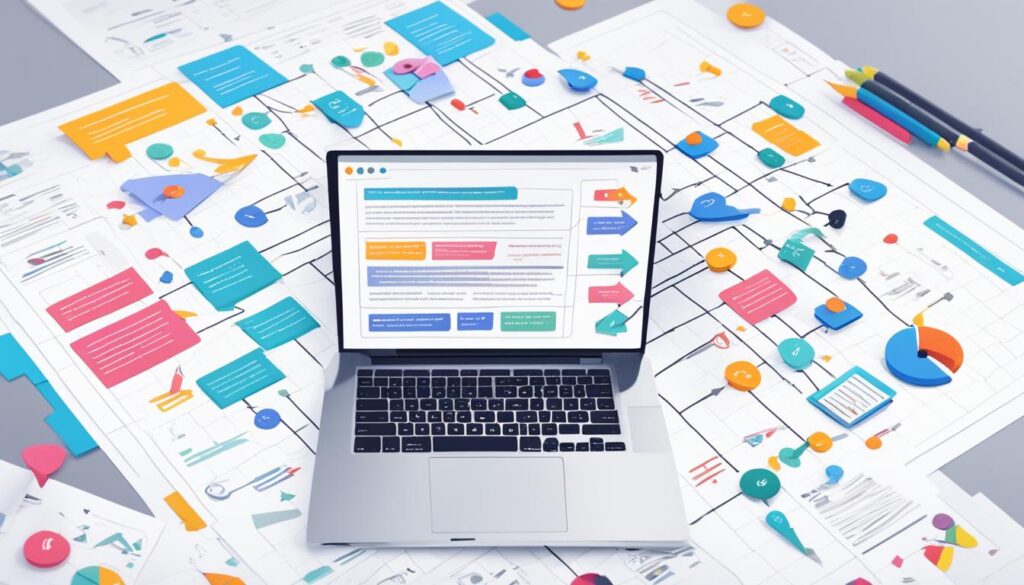
Now that you have a good understanding of the basics, let’s explore the web design process in the next section.
The Web Design Process
As beginners in web design, it’s essential to understand the step-by-step process that goes into creating a successful website. By following this process, you can ensure a smooth and beginner-friendly web design experience.
Setting a Goal
Before diving into the design process, it’s crucial to define the purpose and goal of your website. Determine what you want to achieve with your website, whether it’s to showcase your portfolio, sell products, or provide information to visitors. This goal will guide the entire design process and help you make informed decisions along the way.
Creating a Schedule
Designing a website requires careful planning and organization. Create a schedule that outlines specific timelines for each phase of the design process. This will help you stay on track and ensure that you complete your web design project efficiently and effectively.
Designing a Sitemap and Wireframe
Next, develop a sitemap to outline the structure and navigation of your website. This visual representation will help you understand how different pages connect and relate to each other. Additionally, create a wireframe that acts as a blueprint for the layout and arrangement of elements on each page. This step ensures that your website’s design is intuitive and easy to navigate.
Creating Content
Content plays a vital role in web design. Start by creating compelling and engaging copy that is tailored to your target audience. Simultaneously, gather or create relevant images, videos, and other media that complement your website’s overall aesthetic. Remember, high-quality content enhances the user experience and improves the overall design of your website.
Running Tests
Thoroughly test your website’s functionality, responsiveness, and compatibility across different devices and browsers. Identify and fix any issues or bugs that may arise. Running tests ensures that your website is optimized for a seamless user experience.
Launching the Website
It’s finally time to launch your website and make it live for the world to see. Take the necessary steps to finalize any remaining details, such as connecting your domain, setting up hosting, and optimizing your website for search engines. Once your website is deployed, continue to monitor its performance and make necessary updates as you gather user feedback.

The Web Design Process Overview
| Step | Description |
|---|---|
| 1 | Setting a Goal |
| 2 | Creating a Schedule |
| 3 | Designing a Sitemap and Wireframe |
| 4 | Creating Content |
| 5 | Running Tests |
| 6 | Launching the Website |
Key Elements of Web Design
When it comes to beginner-friendly web design, there are several key elements that you should consider to create a visually appealing and engaging website. These elements include:
- Visual Appearance and Layout: The overall look and feel of your website play a crucial role in attracting and retaining visitors. A clean and organized layout with visually appealing graphics and images can leave a lasting impression.
- Colors: The color scheme you choose sets the mood and tone of your website. Harmonious color combinations can create a visually pleasing experience and convey the right message to your audience.
- Typography: The fonts you use should be legible and easy to read across different devices. Experiment with font styles and sizes to find the right balance between aesthetics and readability.
- Navigation: Intuitive navigation ensures that visitors can easily explore different sections of your website without confusion. Clear and descriptive menu labels, well-organized content, and logical navigation flow contribute to a positive user experience.
- Content: Compelling and relevant content is essential for engaging visitors and encouraging them to stay longer on your website. Break up text with headings, paragraphs, and bullet points for easy scanning.
Incorporating these key elements into your website design will help you create a beginner-friendly web design that not only looks great but also provides a seamless user experience. Check out the following image for a visual representation of these elements:
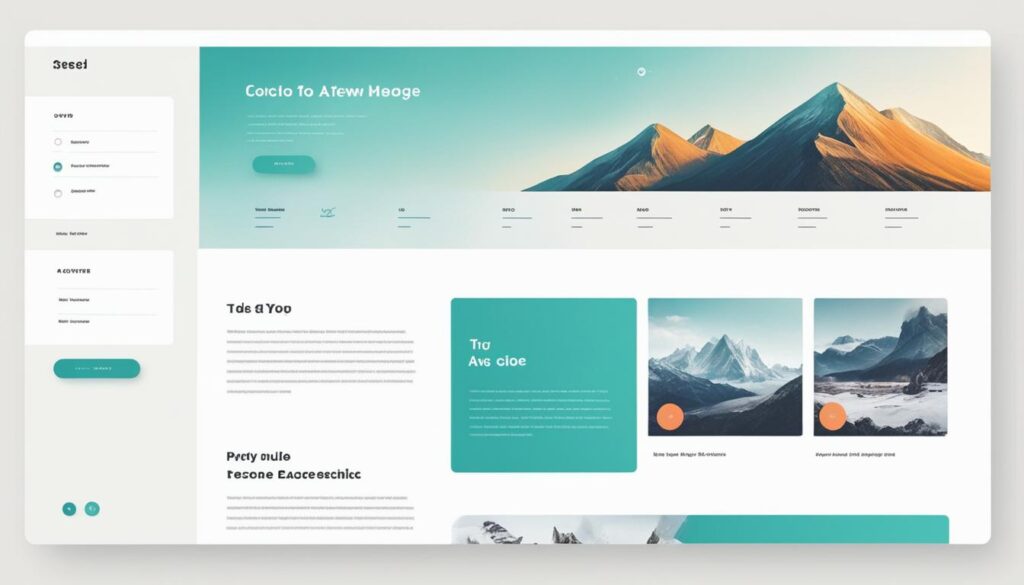
Remember, web design for dummies doesn’t have to be overwhelming. With these website design tips for beginners, you’ll be well on your way to creating stunning websites that captivate your audience.
Choosing the Right Design Inspiration
Finding inspiration is an essential step in the web design process, especially for beginners. By exploring and collecting design inspirations from other talented designers, you can elevate your own skills and create stunning websites. Here are a few platforms and websites where you can discover valuable design inspirations:
- Awwwards: A great platform that showcases award-winning website designs. It provides a collection of visually impressive and innovative designs that can inspire your own creations.
- Behance: A vibrant community of designers where you can explore a wide range of projects and styles. Behance offers a vast collection of design inspirations, including web design, graphic design, and more.
- Dribbble: Known for its focus on design community, Dribbble is a platform where designers share their work and provide inspiration. Whether it’s UI design, illustrations, or animations, you can find a plethora of ideas to fuel your creativity.
- Webflow Showcase: Webflow, a popular web design tool, has its own showcase of beautifully crafted websites. This platform offers a great variety of design styles and approaches, giving you a comprehensive source of inspiration.
Building a collection of websites that resonate with you will serve as a visual guide for your own design choices. It will also help you gain a deeper understanding of what makes a design work effectively. Remember, inspiration can come from anywhere, so explore different platforms, engage with the design community, and let your creativity flourish.

Unlocking Creativity
“Creativity is contagious. Pass it on.”
Design inspiration can often ignite our own creative spark. Exploring unique design concepts and innovative approaches can help you think outside the box and push the boundaries of your own designs. So, make it a point to regularly seek out fresh inspirations, experiment with new ideas, and unleash your creative potential.
Learning from Outside Sources
When it comes to web design, inspiration can be found in unexpected places. Looking beyond the online realm and exploring diverse sources such as graphic novels, art history, and other fields of design can greatly enhance your creative abilities as a web designer. By drawing inspiration from outside sources, you can bring fresh and innovative ideas to your projects, making your designs stand out.
One area to pay special attention to is typography. Typography plays a crucial role in web design, and studying different styles and techniques can help you create visually appealing and impactful websites. By understanding the power of fonts, spacing, and hierarchy, you can effectively communicate your message and create a memorable user experience.
Expanding Your Design Knowledge
“The principles of design are universal. Whether you’re designing a website, a poster, or a piece of furniture, understanding the fundamentals will elevate your work.” – Jonathan Ive
By immersing yourself in different design disciplines, you can broaden your design knowledge and gain valuable insights. Exploring fields such as architecture, industrial design, or even fashion can provide unique perspectives that you can apply to web design. Observing how different forms, colors, and materials are combined in these disciplines can inspire new ideas and push the boundaries of your creativity.
Seeking Inspiration Everywhere
Remember, creativity knows no bounds. As a web designer, you have the opportunity to find inspiration in the world around you. Pay attention to the shapes, patterns, and colors you encounter every day. Take photographs, sketch ideas, and keep a journal of the things that catch your eye. These real-world experiences can fuel your imagination and inform your web design decisions, making your work truly unique and engaging.
Exploring diverse sources and looking outside the realm of web design can unlock endless possibilities for your projects. Embrace the opportunity to learn from various disciplines and be open to inspiration from unexpected places. By infusing your designs with fresh ideas and creative approaches, you can create websites that captivate and engage your audience.
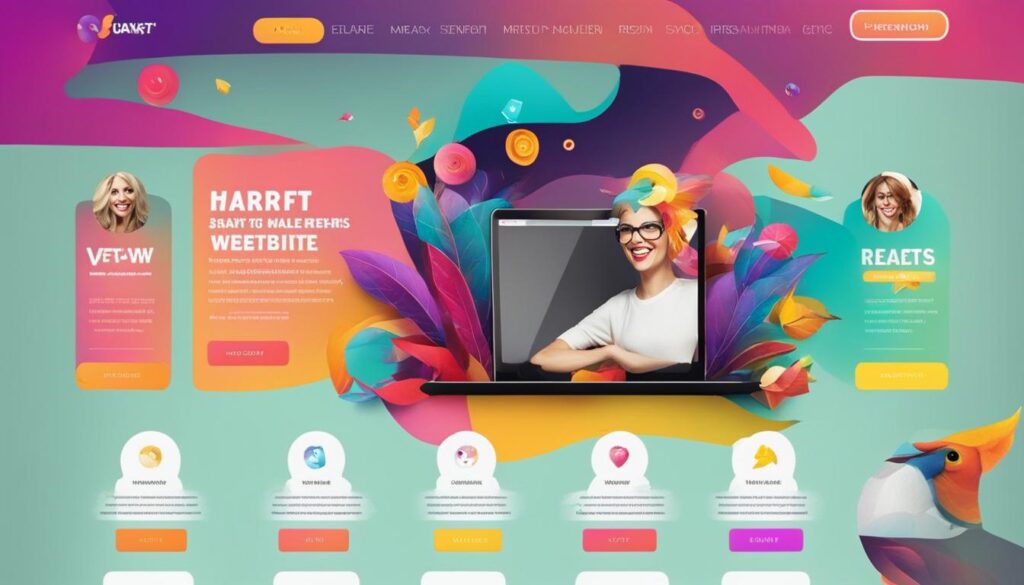
Emphasizing User Experience and User Interface
User experience (UX) and user interface (UI) are two crucial aspects of web design that beginners should prioritize. By focusing on creating a user-friendly and engaging website, you can enhance the overall experience for your visitors.
UX design involves understanding the needs and expectations of users. It focuses on providing a smooth and intuitive browsing experience, ensuring that visitors can easily navigate through your website and find the information or products they’re looking for. By considering factors such as layout, organization, and user flow, you can create a website that is both functional and user-friendly.
On the other hand, UI design deals with creating an interface that is visually appealing and easy to interact with. It involves elements such as buttons, menus, and icons, which should be designed in a way that is intuitive and free of complications. By leveraging color schemes, typography, and visual hierarchy, you can guide users and enhance their overall experience on your website.
When designing your website, consider the following tips to prioritize user experience and user interface:
- Create clear and concise navigation menus that are easy to find and understand.
- Ensure that your website is responsive and mobile-friendly, adapting to different screen sizes for a seamless user experience.
- Use intuitive and descriptive labels for buttons and links, guiding users on what actions to take.
- Optimize page loading times to prevent visitors from getting frustrated or leaving your site.
- Implement search functionality to help users quickly find specific content or products.
Remember, a user-friendly website not only attracts and retains visitors but also contributes to your overall success in achieving your goals. By prioritizing UX and UI in your web design process, you can create a website that offers a positive and engaging user experience.
“Good design is obvious. Great design is transparent.”
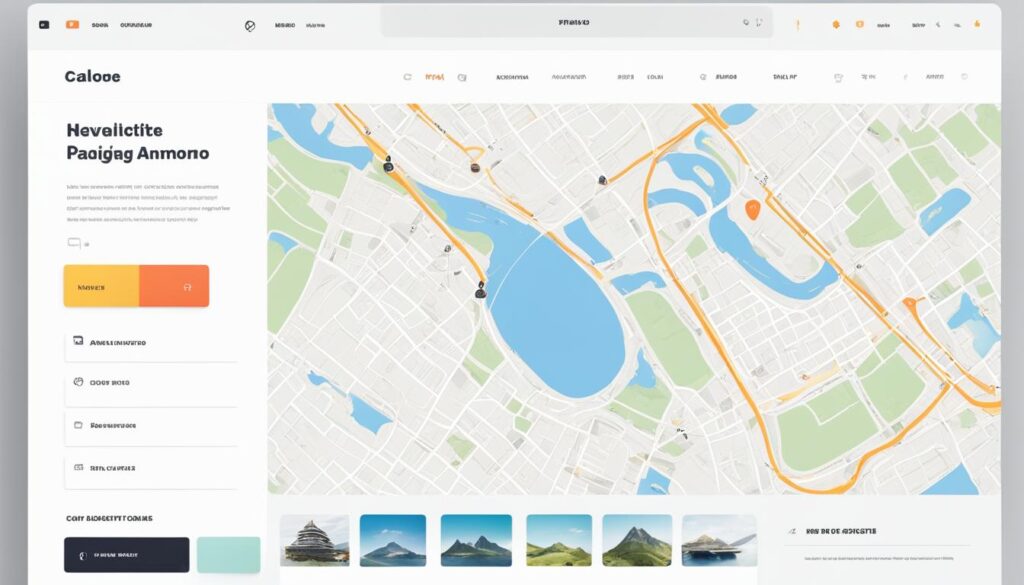
Designing for Accessibility
Another important consideration in web design is accessibility. This involves making your website usable and accessible to individuals with disabilities. By incorporating inclusive design principles, you can ensure that people with visual impairments, hearing impairments, and other disabilities can navigate and interact with your site effectively.
Some key accessibility considerations include:
- Using alt text for images to provide context for visually impaired individuals using screen readers.
- Ensuring proper color contrast to accommodate individuals with visual impairments.
- Providing captions or transcripts for audio and video content to accommodate individuals with hearing impairments.
- Implementing keyboard navigation so that individuals who rely on keyboard-only navigation can access all parts of your website.
By designing with accessibility in mind, you create a more inclusive and user-friendly website that can be accessed and enjoyed by a wider audience.
Optimal Web Design Skills and Practices
As beginners in the world of web design, it’s essential to understand and implement certain optimal skills and practices to create visually appealing and functional websites. By following these guidelines, you can confidently embark on your web design journey and create websites that are beginner-friendly and easy to navigate.
1. Understand and Implement Good Layout Principles
Web design is all about creating a visually pleasing and well-organized layout. Make sure to adhere to basic principles such as balance, proximity, and alignment. Keep your design clean and uncluttered while ensuring that important elements are easily accessible to users. By mastering good layout principles, you can create websites that are aesthetically pleasing and user-friendly.
2. Utilize Whitespace and Grid-based Designs
Whitespace, also known as negative space, is the empty area between elements on a webpage. This space helps create a sense of balance and helps users focus on important content. Incorporating grid-based designs allows you to maintain consistency and alignment throughout your website. These practices enhance readability and user experience, making it easier for visitors to navigate and interact with your website.
3. Choose the Right Color Schemes
Colors play a crucial role in web design, as they evoke emotions and set the tone for a website. Understanding color psychology and selecting appropriate color schemes can greatly enhance the visual appeal and user experience of your website. Consider using contrasting colors to highlight important elements and ensure readability. Strike a balance between creativity and usability to create a website that captivates users.
4. Focus on Typography Readability
Typography is not just about choosing attractive fonts, but also about ensuring readability. Select fonts that are easy to read and consider factors such as font size, line spacing, and paragraph length. Use headings and subheadings to structure your content and guide users through your website. By prioritizing typography readability, you can enhance the overall user experience.
5. Simplify Navigation
One of the key aspects of beginner-friendly web design is easy navigation. Users should be able to find what they’re looking for effortlessly. Keep your navigation menu simple and intuitive. Use descriptive and concise labels for menu items and ensure that important pages are easily accessible from any point on your website. By simplifying navigation, you can create a seamless browsing experience for your users.
Incorporating these optimal web design skills and practices into your projects can help you create visually appealing, beginner-friendly websites that are easy to navigate. By mastering these techniques, you can unlock the world of web design for dummies and confidently embark on your web design journey.
FAQ
What is web design for dummies?
Web design for dummies refers to a beginner-friendly approach to creating websites, making the process accessible to those with little to no prior experience in web design.
Is web design a part of web development?
No, web design and web development are two separate disciplines. Web design focuses on the visual and interactive aspects of a website, while web development involves coding and programming to make the design functional.
What are the steps involved in web design?
The steps in web design include setting goals, creating a schedule, designing a sitemap and wireframe, creating content, running tests, and launching the website.
What are the key elements of web design?
Key elements of web design include visual appearance and layout, colors, typography, navigation, and content.
Where can I find design inspiration for web design?
Platforms such as Awwwards, Behance, Dribbble, and the Webflow showcase are great places to discover and collect design inspirations.
Can I draw inspiration for web design from sources outside of the web?
Absolutely! Drawing inspiration from sources like graphic novels, art history, and different design fields can enhance your creativity and broaden your knowledge.
What is the importance of user experience (UX) and user interface (UI) in web design?
UX focuses on understanding user needs and creating a smooth browsing experience, while UI deals with designing a user-friendly interface. Both are crucial for a positive and engaging user experience.
What are some optimal web design skills and practices?
Optimal web design skills and practices include implementing good layout principles, utilizing whitespace and grid-based designs, choosing the right color schemes, focusing on typography readability, and simplifying navigation.
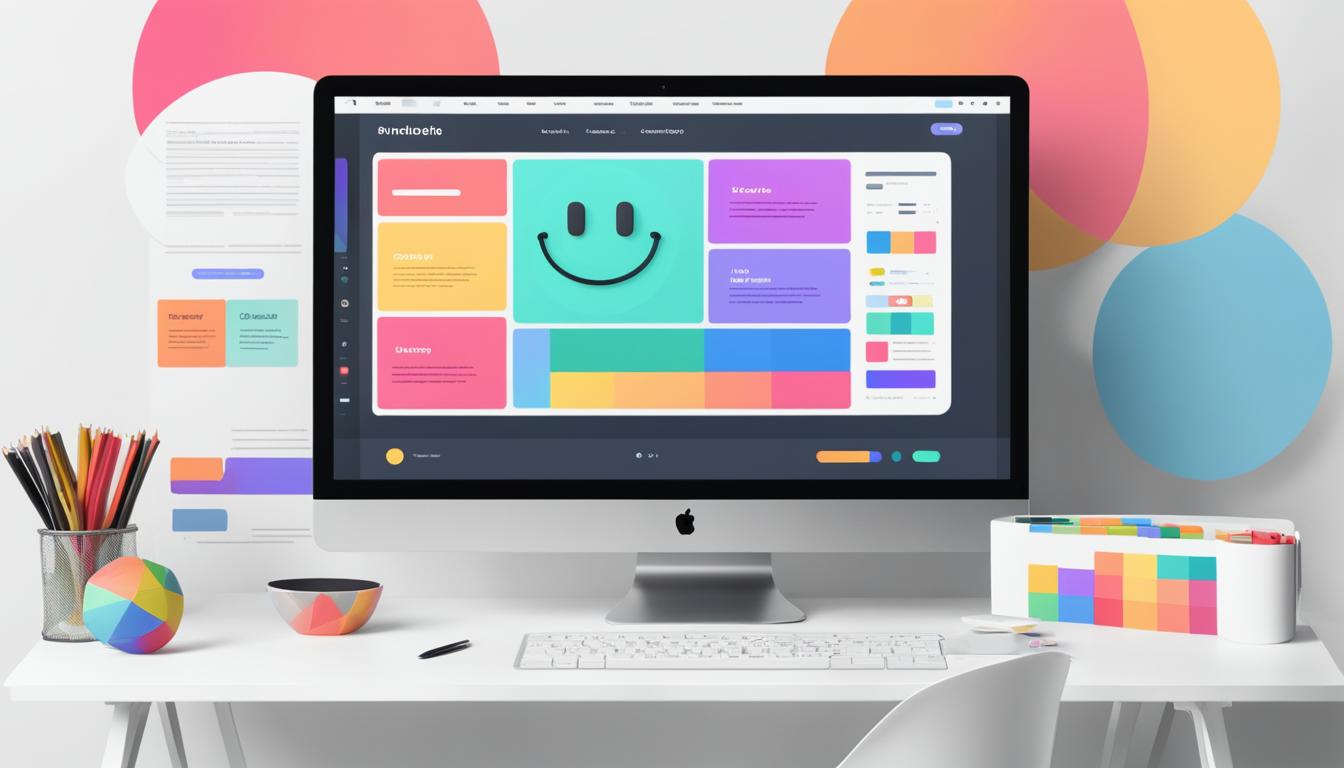
Leave a Reply